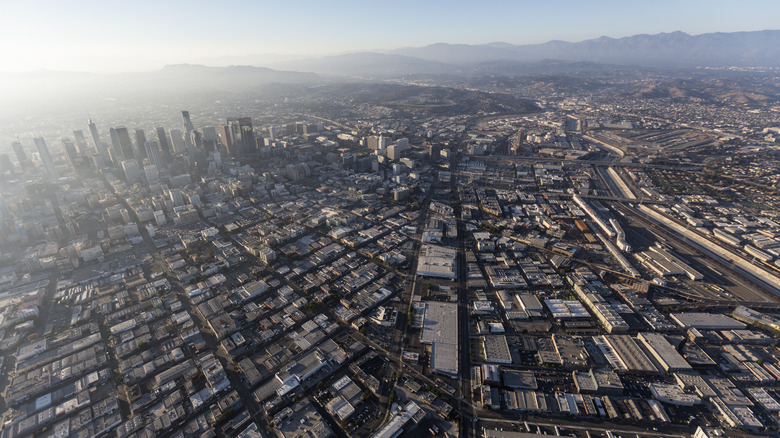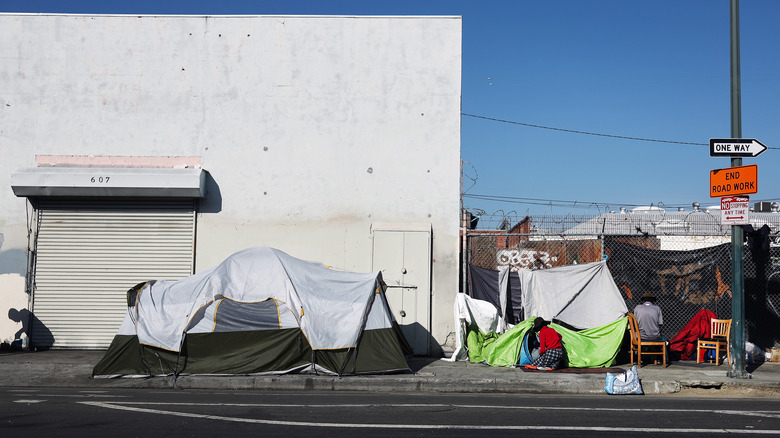How LA's Skid Row Really Got Its Name
Encompassing the segment of LA roughly east of downtown between 3rd Street and 7th Street, Skid Row has come to embody a single image: lanes replete with ramshackle buildings, unhoused people milling around or drooping over from substance abuse, blue tarps draped over piles of cardboard or shopping carts, bashed up storefronts, and so forth. And while other cities have their own version of Skid Row — the Tenderloin in San Francisco, the Bowery in New York, for example — LA's enclave of poverty stands out. In fact, it has taken on almost mythic significance, especially in light of its placement within the city of Hollywood glitz, glamour, and opulence.
It might be tempting to think that Skid Row got its name after it transformed into its present, deteriorated state, as though its people had "hit the skids" or "skid out" on life and lost their proverbial footing. But no, Skid Row got its name before it descended into its current state, following some unwise LA policymaking in the '70s. Los Angeles Times recounts that 1975 saw city officials implement a "containment" policy to confine all the heavy alcohol users as well as the poor and unemployed into one clustered neighborhood. Fast-forward to the present, and we live with the consequences.
The name "Skid Row" actually has a benign origin connected to logging communities. Almanac says that a "skid road" was a stretch of road used to drag logs to mills or bodies of water, and The Seattle Times counts Seattle as the first city to have such a "skid road."
A road where logs skidded
If "Skid Row" comes from "Skid Road" in logging communities, the reader might understandably ask, "What logging communities in Los Angeles, exactly?" Seattle, however — couched in the forest-saturated Pacific Northwest — makes the perfect home for roads where logs once skidded. The Seattle Times says that logs from the Pacific Northwest used to make their way into Seattle proper and toward its waterfront along the Puget Sound. Seattle, if the reader remembers, is a hilly place with lots of up and down slopes. While debate about the actual road that inspired the name remains — either Washington Street, First Avenue, or Yesler Way — everyone agrees that logs used to be greased to help them slide along roads better. Hence: Skid Road. American History says that Seattle's function as a lumber supplier started as far back as the 1850s.
Almanac says that the term "Skid Road," over time, came to be synonymous with cheap neighborhoods and dilapidated buildings. Presumably, this is because regions full of dragged timbre didn't make the best residential or commercial areas. Depending on the frequency of the logs carried down the street — which likely began as unpaved paths — roads would have been extremely chewed up. This is especially true given all of Seattle's rain, which would have carried mud and grit everywhere. And so, by 1915 "Skid Road" took on the meaning of a generally battered, cheap, and unsavory part of town.
Finding a place for Skid Row
No one sat down one day and pointed to the area east of downtown Los Angeles and said, "Thou art Skid Row." In describing the development of LA over time, Discover Los Angeles says that the city settled into its current, districted shape from the late 1800s to the early 1900s, complete with its downtown and Little Tokyo — Skid Row rests adjacent to both. Almanac says that by 1931 folks dropped the "d" from "Skid Road," "making it "Skid Row." By then the term took on its full, modern meaning. At some time between then and the aforementioned 1970s "containment" policy, the name circulated and stuck.
There have been efforts in recent years to rebrand Skid Row by erasing its name, same as there's been pushback against such measures and a simultaneous acceptance of that part of LA's history and self. In 2021, Change.org hosted a petition to change "Skid Row" to "Opportunity Row." Meanwhile, as far back as 2006 firefighters and paramedics insisted that the name Skid Row should remain unchanged because it helps convey the need of the area, per EMS World. Meanwhile, 2015 saw The Guardian discuss desires to gentrify Skid Row, while more recently the Los Angeles Business Journal described plans to build 12-story high-rises in the area for its impoverished. Ultimately, the fate of Skid Row remains uncertain.


